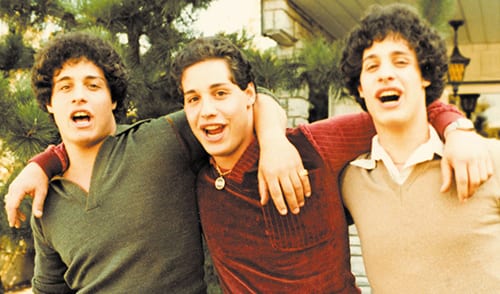The visual effects of ‘Ant-Man and the Wasp’ are improved, but the humor is what gets you.
‘Ant-Man and the Wasp’ packs a sting; the strange truth of ‘3 Identical Strangers’
ARNOLD WAYNE JONES | Executive Editor
jones@dallasvoice.com
If there’s one specific that sets the Marvel Cinematic Universe apart from its cognate at DC, it has to be a sense of humor. Try to remember any moment since Superman II when you laughed at an intentionally funny bit in a DC movie. By contrast, even bloated portmanteau epics like The Avengers: Infinity War find room for levity.
But even Marvel has a hierarchy of humor: The first Iron Man set the tone (as have Robert Downey Jr.’s performances ever since then), and Thor: Ragnarok is almost as much comedy as adventure, but no property was more goofy than Ant-Man: Paul Rudd and Michael Pena are terrific deadpan comedians, and even Michael Douglas has the makings of a classic straightman.
So the fact that new film, Ant-Man and the Wasp — the (gasp!) 20th film in the MCU franchise — delivers more biting laughs per minute than any other film probably should not come as a surprise; the fact it’s also a rolicking action pic is a great bonus.
As we last learned in a throw-away line from Infinity War, Scott Lang aka Ant-Man (Rudd) has been under house arrest for his participation in the rebellion from Captain America: Civil War. We catch up with him at that same point from Infinity War, three days before his ankle bracelet comes off. But Scott has a weird dream, seemingly tied to the moment in Ant-Man when he went subatomic, that makes him reach out to fugitive dad and daughter Hank Pym (Douglas) and Hope van Dyne (Evangeline Lilly). Could their wife and mother (Michelle Pfeiffer), missing for 30 years, still be alive in the quantum realm?
It’s not as complicated as it sounds (or rather, it is, but doesn’t matter), but as the trio try to create a tunnel to the nether world, they are interfered with by a meddlesome moth — a creature called Ghost (Hannah John-Kamen) who phases in and out of corporeal state and needs their tech to save her own life. And she is willing to commit insecticide to have her way. Blah blah blah.
Ant-Man and the Wasp is an improvement on the last Ant-Man film, whose visual effects were more quaint than dazzling; they seem to have worked out the bugs, and director Peyton Reed has ramped up the way the effects are used. Wasp is kick-ass and lightning fast (she flies!).
They use the ability to shrink and expand instantaneously not in a dizzying over-produced way, but as buttons to the action, punchlines to the jokes. And the post-credits cliffhanger, while predictable, still stirred up the audience at the press screening. Even in a comedy, some revelations still sting.

In 1980, a 19-year-old named Robert attended the first day of his freshman year at college and was amazed where everyone seemed to know who he was. Finally one classmate realized he had not just a Doppelganger but an actual twin, separated at birth, named Eddy. The newspapers covered the coincidence as a human interest story, but it grew stranger; the same day the story was published with a photo of the two young men, it turned out a third brother, David, realized he was the missing triplet. Each had been adopted by a different family — working class, middle class and affluent — but otherwise their similarities were beyond appearances. They became immediate fast friends and welcomed each others’ families into their own. The triplets skyrocketed to celebrity overnight.
But their adoptive parents all had the same question: Why weren’t they ever told their adopted son was one of a set? Who had the right to split up this minor miracle of mitochondria multiplication and not inform them?
The parents might have been pissed, but the boys were boys, living outside New York City with a certain cache during the height of the disco era. They were too happy to care about the implications of a decision made while they were in diapers. Until it turned out they really needed to know what the adoption agency hid from them. “[Their] lives were orchestrated by scientific researchers putting their needs above the best interests of the children, someone plaintively observes.
It’s a now-common format for a documentary to be structured as a mystery to be solved, though the initial reveal in Three Identical Strangers — while shockingly horrific — isn’t entirely unexpected. A pall hovers over the entire film from the get-go, but as the cover-ups continue to mount, so does the audience’s frustration.
Through current interviews, old clips and plenty of reenactments, director Tim Wardle constructs a surprisingly loopy tale that uses the brothers as a hook for what happened not only to them, but to others. That’s where things begin to unravel a bit. The story gets repetitive at times (maybe Wardle is aiming to “twin the scenes” as a gimmick, but it doesn’t work), and he makes vague gestures toward certain larger implications (the Holocaust is mentioned — “When you play with humans you do something very wrong,” one person observes), but the narrative loses focus. It coasts for a long while on our amazement at the arrogance of shadowy, autocratic researchers, but the more I thought about Three Identical Strangers, the less I was sure exactly what I had spent 100 minutes watching, and its broader import gets murky. Then again, truth really is stranger than fiction… and it doesn’t always wrap itself up in a tidy way.
Both films now playing.












